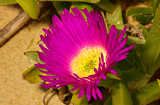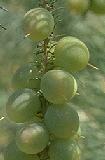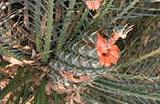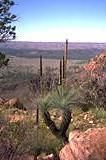|
[Front Page] [Features] [Departments] [SGAP Home Page] [Subscribe]

Aboriginal Uses of Plants Around Sydney
Les Robinson
While looking for historical references to Sydney plants for "Field Guide to the Native Plants of Sydney", I read most of the early journals of botanically literate early Sydney settlers and explorers (of which there were a surprising number). This article is based upon that research.
The Aboriginal tribes around Sydney were virtually exterminated or moved on early in the era of European settlement. Aborigines still living around the region retain an oral record of plant use, although it has rarely been put into writing. Hence almost our only data on plant use comes from the historical records of early European settlers who observed, but rarely had intimate contact with Aborigines.
It is my assertion, (not backed up by any kind of historical, scientific or anthropological evidence, but logical nevertheless!), that Aborigines, living in intimate connection with the land for many thousands of years, can be reasonably expected to have used VIRTUALLY EVERYTHING that was useable to them. I can say this because in only a few years, by casual experimentation (ceaseless tasting, pulling, testing, etc..) I have come to learn a lot about the local bush...how much more would Aborigines have known!
So this article is about Sydney region plants known to be useful and hence likely to have been used by Aborigines.
Fruits
The fruits of Sydney plants, seasonal, small and insipid for the most part, cannot have been a significant source of nutrition for Aborigines. Nevertheless, because of their visibility they are the best recorded of the local food plants. They include the well known and much written-about fruits, as well as some more obscure ones:
Astroloma humifusum
Billardiera scandens
Brachychiton spp. (seeds roasted)
Canavalia marina (bean roasted)
Carpobrotus glaucescens
Cassytha spp.
Cayratia clematidea
Choretrum candollei
|
Cissus spp.
Eremophila spp.
Exocarpos cupressiformis
Eugenia smithii
Ficus spp.
Leptomeria acida
Leucopogon spp.
Lissanthe spp.
Monotoca elliptica
Myoporum spp.
|
Omphacomeria acerba
Persoonia spp.
Podocarpus elatus
Rubus spp.
Sambucus australasica
Santalum obtusifolium
Scaevola calendulacea
Schizomeria ovata
Styphelia spp.
Tasmannia insipida
|
 |
Carpobrotus glaucescens, commonly know as "pig face", is found along coastal dunes of eastern Australia. Select the thumbnail image or plant name for a higher resolution image (36k).
|
 |
The fruits of Persoonia species are edible but not particularly palatable. This is Persoonia pinifolia. Select the thumbnail image or plant name for a higher resolution image (29k).
|
In the research for my book I never uncovered a reference to Aborigines eating Planchonella australis fruits, even though they are the fleshiest and best eating of the local fruits. Nor did I find references to Eupomatia, Syzygium, Schizomeria fruits, or several other common rainforest fruits which are certainly edible...this points to the paucity of records and indicates how scanty our knowledge really is. Even a normally toxic plant like Solanum aviculare was eaten by Victorian Aborigines after roasting: was it eaten here? We'll probably never know.
This brings up another issue: how many plants were regular foods and how many were emergency foods, consumed only in the lean and desperate times? A great many of the foods in this list must have been in that category.
Greens
There is no evidence that the famous 'Botany Bay greens' were consumed by Sydney Aborigines (Tetragonia tetragonioides, Apium prostratum, Atriplex cinerea). In fact there is not a lot of evidence that greens were all that important to Aborigines. There are records that they roasted a few species:
| EIatostemma reticulatum | |
| Doryanthes excelsa | Young flowering stems, at Port Macquarie |
| Avicennia australis | Leafy expanding fruits roasted, in northern Australia |
| Phragmites australis | Young stems, in Tasmania |
Interestingly, it appears that Sydney Aborigines did not eat the cabbage of Livistona australis (according to James Backhouse), a rich source for European settlers who did appreciate their greens.
Roots, Tubers, Bulbs etc
Many Liliaceae, Orchidaceae and other families have species with edible tubers and these would have been common foodstuffs for coastal Aborigines. They are not large: you'd have to collect a lot to feed a growing family.
Alocasia brisbaniensis
Arthropodium spp.
Burchardia umbellata
Caesia spp.
Calandrinia pickeringii
Cryptostylis spp.
Cymbonotus lawsonianus
Dichopogon fimbriatus
|
Diuris spp.
Erodium spp.
Gastrodia sesamoides
Glycine spp.
Hypoxis hygrometrica
Ipmoea spp. (I.batatas is the sweet potato)
|
Marsdenia flavescens (by Aborigines on the Hawkesbury River..but not suitable for
Europeans)
Murdannia graminea
Thysanotus spp.
Triglochin spp.
Typha spp.
|
Staples
While the preceding were minor food sources which you could live without, the following were major sources of starch, critical to the survival of coastal Aborigines.
| Blechnum indicum | Bungwall fern - rhizome; all year, but probably best in winter |
| Pteridium esculentum | Bracken fern - rhizome; all year, but probably best in winter |
| Macrozamia communis | Burrawang - seeds; in winter |
Note that these are all, at best, winter foods...does this explain why Aborigines were roasting fibrous and unpalatable Doryanthes stems in spring?
 |
The seeds of Burrawang, Macrozamia communis, require treatment to remove toxins prior to eating. Select the thumbnail image or plant name for a higher resolution image (40k).
|
Flours
The seeds of some grass species were ground into a paste and roasted in the ground to make a kind of damper, with a much higher fibre content that the doughy British version!
| Eragrostis spp. | Central Australia |
| Panicum spp. | |
| Acacia spp. | Seeds |
Interestingly, the pollen of Typha spp. (which occurs in great abundance in summer), is cooked in the same way and eaten in other countries. I was not able to find a record of this happening here.
Canoe Hulls
Canoes were made from the thick fibrous bark of several species, carefully cut away in whole sheets. There are records of the following local species being used.
Casuarina glauca
Eucalyptus agglomerata
Eucalyptus oblonga
|
Eucalyptus botryoides
Corymbia gummifera
|
Rope and String
Many local climbers have strong, fibrous stems useful as ropes without further treatment.
| Kennedia prostrata | |
| SmiIax australis | |
| Ripogonum album | |
| Cissus antarctica | Recorded as a rope for climbing, by looping around both the trunk and the climber |
Flagellaria indica is our own Sydney cane...Aborigines in Arnhem Land used thin strips of stem to bind baskets and sew together sections of canoe hulls. We don't know if or how local Aborigines used the cane, but it is inconceivable that such a useful substance was not exploited.
The leaves of Gymnostachys anceps are also fabulously strong... there are records of their use as string by Europeans, but not by Aborigines.
Fibres
The following were used for twine, nets and net-bags.
| Brachychiton spp. | Inner bark |
| Commersonia fraseri | Inner bark |
| Eupomatia laurina | Inner bark |
| Lomandra multiflora | Leaves |
| Lomandra longifolia | Leaves |
| Hibiscus heterophyllus | Bark |
Fish Poisons
The bark and leaves of various plants were used as 'fish poisons' to stun fish in waterholes, making them float to the surface and easy to catch.
| Acacia spp. | Species such as A.longifolia, A.implexa...but many other species could have been used. All are rich in tannin, the presumed active agent |
| Persicaria spp. | Hunter River and in Queensland |
| Duboisia myoporoides | |
Spear Shafts
| Xanthorrhoea spp. | See below |
Resin
| Xanthorrhoea spp. | See below |
| Corymbia gummifera | Fibres soaked in this before making into string |
Sandpaper
Medicines
Interestingly, there are few records of Aborigines anywhere in Australia using the aromatic plants of the families Myrtaceae, Rutaceae or Sapindaceae (the pinnate-leaved members of Dodonaea) in the same way that we use penetrating aromatic oils, as lung and nasal decongestants and anti-bacterials (tea-tree oil is the classic example). This is surprising, for these are plants are very conspicuous for their odours.
I was able to uncover records of only 12 Sydney plants used medicinally by Aborigines, and_most of these uses are by Aborigines other than those around Sydney. This is not a great number, and again points to the poverty of our written records. These are:
| Acacia falcata | "embrocation made from bark" for skin diseases |
| Acacia implexa | ditto |
| Alphitonia excelsa | Leaves used as skin disinfectant, in Arnhem Land |
| Carpobrotus glaucescens | Steamed and eaten as a purgative, in Tasmania |
| Clematis glycinoides | Crushed leaves used for headaches |
| Crinum pedunculatum | Leaf juice rubbed on marine stings, in Queensland |
| Cynthia spp. | Young fronds roasted and consumed as a tonic after illness |
| Dodonaea triquetra | It was an important medicinal plant amongst Aborigines. The leaves were chewed for toothache, used as a poultice for stonefish and stingray wounds, and soaked in water and used as a sponge to relieve fever. A liquid made from soaking the roots was used for open cuts and sores |
| Duboisia myoporoides | Holes made in trunk and filled with water, later extracted and drunk as an intoxicant, in NSW |
| Piper novae-hollandiae | Leaves chewed for sore gums, probably in Queensland |
| Pteridium esculentum | Juice from young stems used against insect bites, probably in Queensland |
| Smilax glyciphila | Leaves sucked at Jervis Bay: for pleasure or medicine? |
Some Historical Records
of a few of the more important species
Xanthorrhoea spp.
"Leaf bases, young flowers and shoots eaten in spring and after fires (not at Jervis Bay). Flower stalk of ssp.concava considered better than ssp.resinosa for making a fishing spear. When dry used for fire lighting." - at Jervis Bay.
"Sap (from yellow variety only) used as gum, generally to secure a bunding of plant fibre. Examples of such usage are the fixing of prongs and points to fishing spears, and fish hooks to their lines. May be removed as a powder from leaf bases by beating them; sometimes found as a hardened knob on northern side of a tree, where it has been exuded by the sun's heat." (Surgeon White's journal, 1788).
 |
Xanthorrhoea species were important for making a range of tools and weapons. Select the thumbnail image or plant name for a higher resolution image (38k).
|
"Their spears are made of a kind of cane which grows out of the tree that produces the yellow gum; they are ten to twelve feet long, pointed, and sometimes barbed, with a piece of the same cane or the teeth of a fish. These they throw, with the assistance of the short stick already mentioned which has a shell made fast to the end of it with the yellow gum." (Surgeon Whlte's journal, 1788).
"'The Yellow Resin Tree'....resin, the properties of which vie with the most fragrant balsams...Perfectly soluble in spirit of wine, but not in water, nor even In essential oil of turpentine...With respect to its medicinal properties Mr White has found it, in many cases, a good pectoral medicine, and very balsamic...The plant...seems to be perfectly unknown to botanists, but Mr White has communicated no specimens by which its genus or even class could be determined." (J. E. Smith's appendix to White's journal).
"The bases of the inner leaves of the grass-tree are not to be despised by the hungry. The aborigines beat off the heads of these singular plants by striking them about the top of the trunk with a large stick; then they stript off the outer leaves and cut away the inner ones, leaving about an inch and a half of the white tender portion joining the trunk; this portion they ate raw or roasted, and it is far from disagreeable in flavour, having a nutty taste, slightly balsamic." (James Backhouse, 1843, describing usage in Tasmania).
"In 1825, when Captain Smith, of the 'Caledonia', was at Western Port, he discovered a quantity of it [the resin], and, by boiling it with oil, made a very good and cheap composition for covering the bottom of his vessel, instead of pitch." (Daniel Bunce, Travels with Dr Leichhardt, 1859).
Macrozamia communis
The large nuts are poisonous until soaked in water for several days. When crushed a high quality starch Is produced, said to resemble arrowroot. It was a staple food for Aborigines and was eaten by early settlers near Braidwood, NSW. Available mainly in winter. Aborigines prepared it by cutting it into slices and washing in water for several days.
The NSW Medical Gazette of 1871 recorded that a Henry Moss writes to the editor to inform him that he won a bronze medal and diploma from the Paris Exhibition for a sample of arrowroot manufactured from the Burrawang nut...pounded in tubs of water, roughly strained to remove debris from nut..strained through fine cheese cloth...liquid allowed to stand for 48 hours in a long cask, plenty of fresh water being added in the interval...spike holes in the cask within a few inches of the bottom allowed the water to be drawed off without disturbing the sediment in any way...After draining and re-adding pure water several times, until the (poisonous) oil disappeared, then the arrowroot formed a cake at the bottom...dried in the sun and reduced fine by rolling. 'Equal to any commercial arrowroot..l think it would be first rate for a company to go into the affair. He believed the Aborigines chief food was this nut, pounded up and then placed on a sheet of bark under a gentle fall of water for two days (to remove the 'pernicious' oil). [Vol 2, 1871-72, Sydney, p88 (1871)1.
Pteridium esculenlum/Blechnum indicum
Consumption of Pteridium esculenlum would be discouraged today because it is considered to contain a human carcinogen, but it once formed a staple for Aborigines around Sydney. Blechnum indicum was also consumed around Sydney. The white starchy centre of the rhizome can be eaten raw and is quite acceptable to a European taste. The following descriptions relate to Pteridium, but the Mahroot excerpt may also relate to Blechnum, which was once found in abundance in the swampy eastern suburbs.
"The Aborigines roast this root in the ashes, peel off its black skin with their teeth, and eat it with their roasted kangaroo, &c. in the same manner as Europeans eat bread." He also notes that prolonged use induces weakness. (J. Backhouse p.xxxix - esculent Plants of Tasmania).
Mahroot was an aborigine born at Cook's River and living at La Perouse who was called to give evidence to the NSW Leg. Council C'ttee on the Condition of the Aborigines in 1845.
"Commlttee - What did you live upon [before the whites came]?
Mahroot - Generally on the sea coast fish and the fern root.
The Chairman - What clothing used the black fellows to have before they used to come into the town to the whites, what did they have to put on?
Mahroot - Sometimes they had tea tree (Melaleuca) bark, and sometimes Kangaroo skins from foreign parts..[ie away from the coast]."
Roasted in ashes "a staple, eaten in greater quantities when fish were scarce"- at Jervis Bay.
Oct 1788, William Bradley wrote "The fern and some other roots they prepare by moistening and beating between two stones a considerable time before they use it."
This article is a reproduction of a paper presented at the SGAP 17th Biennial Seminar, Robert Menzies College, Sydney, 27 September to 1 October 1993.
Les Robinson is the author of the "Field Guide to the Native Plants of Sydney", a comprehensive and fully-illustrated reference that fits easily into a back pack. He has been a cartoonist and an environmental activist and has not yet died of poisoning from eating anything he has come across in the bush!

[Front Page] [Features] [Departments] [SGAP Home Page] [Subscribe]
Australian Plants online - June 1998
The Society for Growing Australian Plants
|





